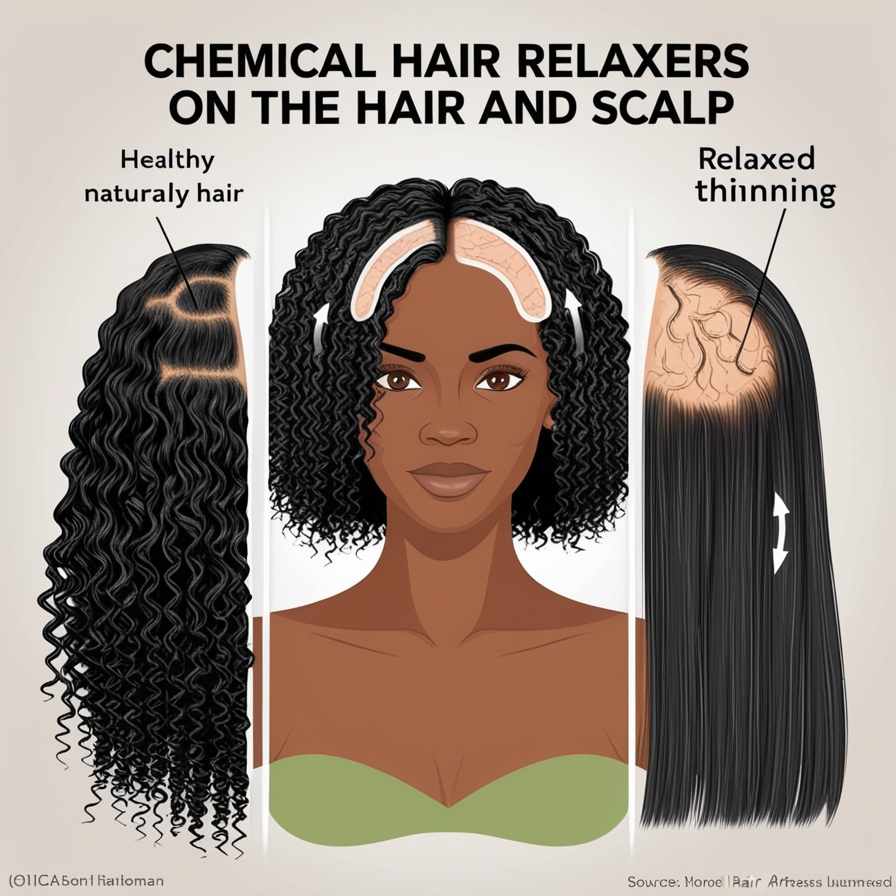Hair relaxers are widely used to straighten naturally curly or wavy hair, offering a sleek, manageable look, while they can transform your hairstyle, it’s important to understand the potential side effects to make informed decisions about their use, this article provides a detailed, fact-based explanation of the possible risks and how to minimize them.
1. Scalp Irritation and Burns
Hair relaxers contain strong chemicals like sodium hydroxide, guanidine hydroxide, or ammonium thioglycolate, which work by breaking down the hair’s natural structure. These chemicals can cause.
Irritation. Redness, itching, or tenderness of the scalp.
Chemical Burns. Improper application or leaving the relaxer on too long can lead to burns.
To avoid this, always follow the product’s instructions carefully or consult a professional stylist.
2. Hair Damage
The chemical process of relaxing hair can weaken the strands, leading to
Brittle Hair. Hair may lose its elasticity and become prone to snapping.
Split Ends. The ends of the hair may fray due to weakened fibers.
Thinning. Over time, the hair may appear less voluminous.
Using deep conditioners and limiting the frequency of relaxer applications can help reduce these risks.
3. Allergic Reactions
Some people may be allergic to the ingredients in hair relaxers, causing symptoms such as.
Redness or rashes on the scalp or surrounding skin.
Swelling and discomfort.
To prevent allergic reactions, always perform a patch test before using a new product.
4. Hair Loss
Hair relaxers can lead to hair loss, especially when.
Overused or applied too frequently.
Combined with tight hairstyles that put extra tension on the hair.
Avoid applying relaxers to already processed hair and space out treatments by at least six to eight weeks, using gentle hairstyles can also prevent unnecessary stress on the hair.
5. Scalp Infections
Improper application can leave the scalp with open wounds or burns, increasing the risk of infection, signs of infection include redness, swelling, or pus formation. Seek medical attention if these symptoms occur.
6. Long-Term Health Risks
Recent studies have raised concerns about the potential health risks of certain hair relaxers.
Hormonal Disruption. Some relaxers may contain endocrine-disrupting chemicals, which can interfere with hormone regulation in the body.
Increased Cancer Risk. A 2022 study suggested a possible link between frequent use of hair straighteners and an increased risk of uterine cancer, while more research is needed, it is essential to be cautious about long-term use.
7. Permanent Loss of Natural Curl Pattern
Relaxers permanently alter the structure of your hair, and this change cannot be reversed, If not applied evenly, they can also result in an uneven texture, leaving some sections straighter than others.
How to Minimize the Risks of Hair Relaxers
Here are some practical tips to reduce the side effects of hair relaxers.
Consult a Professional. Have your relaxer applied by a trained stylist who understands the correct techniques.
Avoid Overlapping. Do not reapply relaxers to hair that has already been processed.
Space Out Treatments. Wait at least six to eight weeks between relaxer applications to prevent over processing.
Deep Condition Regularly. Use deep conditioning treatments to restore moisture and improve the strength of your hair.
Use Gentle Products. Go for shampoos and conditioners that are sulfate-free and designed for chemically treated hair.
Limit Heat Styling. Excessive heat styling can compound damage to relaxed hair.
Alternatives to Hair Relaxers
If you are concerned about the side effects, consider these alternatives.
Natural Hair Care. Embrace and care for your natural hair texture using products designed for your curl type.
Heat Styling. Temporarily straighten your hair with a flat iron or blow dryer, but avoid frequent use.
Protective Styles. Braids, twists, or wigs can provide versatile styling options without chemical treatments.
Final Thoughts
While hair relaxers can help achieve a polished look, it’s crucial to understand the potential side effects and take steps to minimize harm, by following proper application techniques, using high-quality products, and considering alternatives, you can maintain healthy hair and a healthy scalp.
Remember, your hair is an extension of your overall health, so treat it with care and make informed choices for its well-being.

